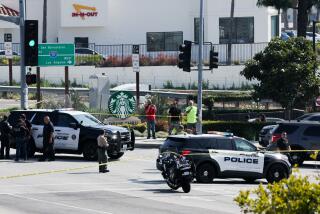At least nine I-5 crash survivors unaccounted for
Authorities were working Monday to learn the identities of a number of survivors who apparently walked away from this weekend’s fiery crash in an Interstate 5 truck tunnel, and, as far as officials are concerned, disappeared into thin air.
At least nine unaccounted-for drivers are presumed to have been in the tunnel at the time of the massive chain-reaction crash that temporarily severed California’s primary north-south traffic artery Friday night.
Two men and a 6-year-old boy died in the 1,500-degree inferno that engulfed 30 big rigs and one passenger vehicle. Ten people were treated for mild and moderate injuries, and 10 others escaped unharmed.
That left nine vehicles with drivers, and possibly passengers, unaccounted for.
California Highway Patrol investigators said they were confident only three people died.
“We have no idea” what became of those who have not been in touch with authorities, said CHP Assistant Chief Warren Stanley on Monday. “We haven’t identified all the vehicles, we haven’t identified all the drivers.”
The tunnel, which primarily carries truck traffic, has been closed indefinitely. As a result, big rigs have been routed to commuter traffic lanes atop the scorched passageway.
The heavily used, 1970s-era tunnel has been the site of relatively few accidents in the last three years, and the subject of no formal complaints from trucking companies, labor unions or professional associations, according to Caltrans officials.
Douglas Failing, Caltrans director for Los Angeles and Ventura counties, said there had been five accidents and no fatalities within 1,000 feet of the two-lane tunnel from 2004 through 2006. “It is well below other similar areas,” he said.
Some truckers, however, said the dark, curving tunnel was known to be dangerous.
“I have driven a gasoline tanker truck through the Santa Clarita tunnel more times than I care to remember,” said Bill Stech, 50, of Bakersfield. “The steep descending grade, the turns, the blind spots and the barely illuminated tunnel make for one of the hairiest stretches of highway I’ve ever driven.”
Failing said Caltrans is considering improving the lighting in the tunnel, adding flashing warning signs and lowering its 55-mph speed limit.
The cause of the accident remains under investigation.
The dead have yet to be identified officially, but one likely casualty was trucker Ricardo Cibrian. He called a friend from his cell phone to say he was trapped in the wreckage. Then the friend heard an explosion, and the line went dead, according to a neighbor who said she learned of the call from Cibrian’s wife.
“They told us that they found his body. They found his body in the truck,” said the neighbor, 21-year-old Espree Campos. “He said that the truck in front was on fire and the car behind him hit his truck and he was trapped.” she said.
Cibrian’s wife, Victoria Martinez, was headed to Mexico on Monday to obtain dental records that could confirm her husband’s identity, Campos said.
Surprisingly, local officials and commuters avoided serious travel headaches Monday.
Motorists who anticipated blockage seeped onto secondary roads rather than chancing the newly reopened passageway on I-5 just south of the California 14 intersection. Others ventured onto the freeway after giving themselves more time than usual for their commutes.
Still others left their cars at home and queued in front of ticket machines at Metrolink stations. Rail officials had added more cars to accommodate the increase in riders.
In all, traffic on the freeway, which reopened at 3 a.m. Monday -- earlier than Caltrans officials had anticipated -- was lighter than usual.
“We’re terribly relieved,” said John Lutz, a CHP spokesman.
“We think the crisis may have passed,” said Metrolink spokeswoman Denise Tyrrell.
Below the freeway’s passenger car lanes, the truck tunnel remained closed and probably will remain so for months, officials said.
Failing said officials were trying to determine the extent of the damage to the steel and concrete tunnel. The fire burned so intensely that it melted concrete and caused steel reinforcement bars to pull away from the concrete.
State transit officials have installed supports to buttress the tunnel’s roof.
Signs of the accident’s magnitude were abundant outside the tunnel -- from the blackened, blistered walls to the smashed cantaloupes and dented cans that lay against a pillar that a produce truck smashed into just outside the tunnel.
Thousands of nails littered the ground, remnants of another truck that lost its cargo in the accident.
Stanley called the crash “the worst . . . I have personally seen” in 25 years with CHP. The intense heat reduced much of the wreckage to ashes, molten metal and partial hulks.
“All that was left of one big rig was part of the engine block and a little bit of the frame,” Stanley said.
Some truckers were concerned that the tunnel’s closure will pose serious problems for big riggers, adding to fuel costs, delaying deliveries and complicating the delicate choreography at major warehouses and distribution sites.
Secondary roads, they said, weren’t made to handle heavier loads.
“I don’t know what it’s going to be like,” said 43-year-old John Stipetich, a 10-year veteran trucker. “It’s the only interstate that connects northern and southern California.
“If any part of it shuts down, there’s just no good way around it.”
Times staff writers Scott Gold, Jason Song, John Paul Renaud, James Ricci and Jeff Rabin contributed to this report.
--
ann.simmons@latimes.com
dan.weikel@latimes.com
More to Read
Start your day right
Sign up for Essential California for news, features and recommendations from the L.A. Times and beyond in your inbox six days a week.
You may occasionally receive promotional content from the Los Angeles Times.








